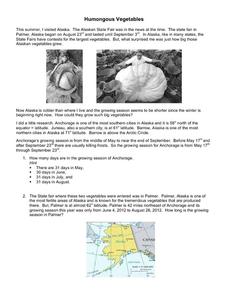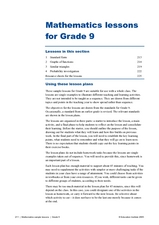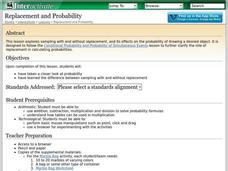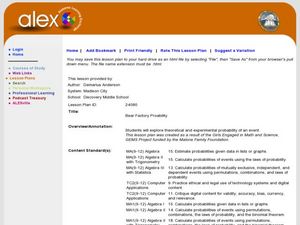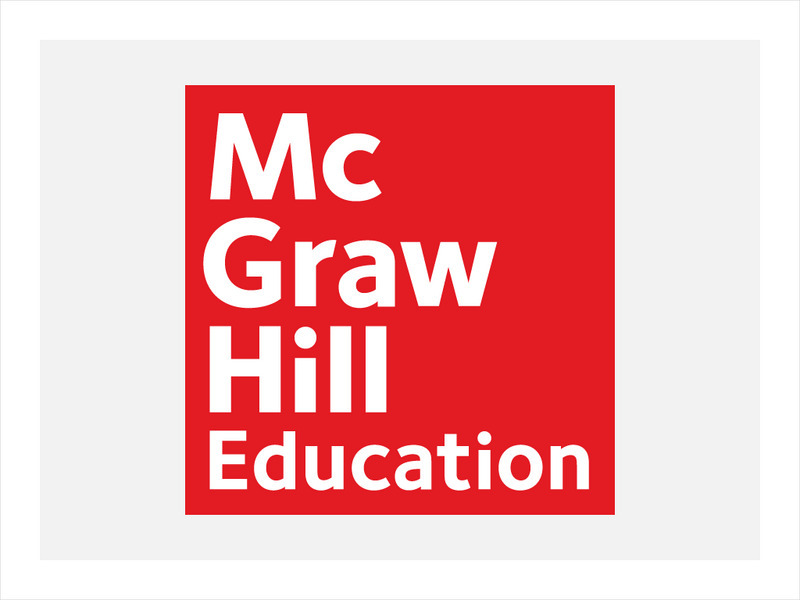Illustrative Mathematics
Tossing Cylinders
Everyone loves a lesson that involves throwing things around! To understand probability, your experimenters will predict how different cylinder-shaped objects will land when tossed. When the data is collected, they will calculate the...
Illustrative Mathematics
Heads or Tails
Heads! A great way to practice probability is to flip a coin in class. The provided data allows your mathematicians to predict the probability of heads in ten coin flips. Bring coins to class and allow your own trial of heads or tails....
Curated OER
Charity Fair
What is the probability of picking the same color ball out of three identical barrels? If you wanted to design a game that made money, how could you structure a game and what would you charge for each chance? How much should you pay a...
Curated OER
Humongous Vegetables
Humongous vegetables can inspire and awaken your mathematicians to the large math concepts in our Common Core standards. What is the secret to growing such gargantuan garden objects in Alaska? In the state that is closest to the...
Education Institute
Four Mathematics Lessons for Grade 9
These four lesson plans build algebra skills for working with numbers in exponential form and for examining triangles. Be aware that in the text, scientific notation is referred to as index notation and the laws of exponents as the laws...
101 Questions
Yellow Starbursts
Let the task burst your mind. Scholars estimate the frequency that both Starbursts in a pack are yellow out of 287 packs. They apply probability concepts to complete the sweet task.
Math Worksheets Land
Probability of Chance Events - Independent Practice Worksheet
What are the chances of pulling out a green from a box of pencils? Now you can find out after sharpening your probability skill set with this resource. Practice different types of experimental probability and use the additional...
Math Worksheets Land
Probability of Chance Events - Matching Worksheet
When choosing items probability can sometimes play a key role. Your mathematicians will explore this probability and how to calculate the values based on the scenario they have. Use this worksheet along with the additional resources...
Math Worksheets Land
Probability of Chance Events - Step-by-Step Lesson
We know a coin should have a 50/50 chance of landing on tails. But what is the probability if it lands 43 out of 83 times? Use the lesson and accompanying resources to teach, practice, and assess about probability of events.
Wake Forest University
Authentic Activities for Connecting Mathematics to the Real World
Check out the handout from a presentation that contains a collection of high school algebra projects connecting a variety of mathematics to the real world. Activities range from simple probabilities to calculus. The activities...
Heidi Songs
Zoo Animal Probability Graph
Capture the engagement of your young mathematicians with a collaborative graphing activity. Using a deck of zoo animal picture cards, students select a picture from the deck, record the chosen animal on a graph,...
Math12
Basics of Probability
Give your students a fighting chance at understanding probability. Offering numerous examples that clearly demonstrate basic probability concepts, this resource helps young mathematicians learn how to visualize the...
Curated OER
Election Poll, Variation 3
Build on probability and incorporate a random number generator to select outcomes for a school election. Your learners will record their results on a dot plot and answer questions regarding whether their candidate has a chance at the...
Curated OER
Election Poll, Variation 2
When a random sample isn't enough, your math class can compare the data from a physical simulation to decide if the probability is still likely. The lesson is part of a probability series that focuses on one question and different ways...
Illustrative Mathematics
Rolling Dice
Rolling dice is a great way for your mathematicians to get a hands-on approach to probabilities. Use the chart to record whether they rolled a six during ten attempts. Calculate results individually (or in small groups) and then record...
Shodor Education Foundation
Replacement and Probability
Middle and high schoolers explore the concept of probability. In this probability lesson, learners conduct an experiment with a bag of marbles. Pupils draw marbles from a bag and determine the probability of drawing a particular color...
PBS
Remove One
With a set of 15 chips and a number line, learners predict what sums may occur with the rolling of two dice. When their sum comes up, they remove one of the chips from their number line with the objective of being the first to remove...
Alabama Learning Exchange
Bear Factory Probability
By examining a set of dice roll data, statisticians determine the probability of different sums occurring. They visit an interactive website and determine how many different vacation outfits Bobbie Bear will have based on the colored...
Alabama Learning Exchange
Probability with Tree Diagrams
Middle school math whizzes view a PowerPoint tutorial on tree diagrams. Using "Anthonio's Pizza Palace," an interactive activity involving the selection of pizza toppings, they use Pascal's triangle as a tree diagram. This is an...
Curated OER
Take A Chance Or Two
A two-part lesson immerses young statisticians in the concept of probability. On the first day, will conduct experiments with a two-colored coin and learn how to write probabilities as fractions, ratios, and percentages. In the second...
Shodor Education Foundation
Shodor Interactivate: Lesson: Fire!, Probability, and Chaos
Young scholars will simulate the probability of a forest fire then graphing the data.
Shodor Education Foundation
Shodor Interactivate: From Probability to Combinatorics and Number Theory
Apply division to determine the probability of outcomes with a racing game.
McGraw Hill
Glencoe: Self Check Quizzes the Language of Chance
Questions are randomly created to quiz learners on the language of chance. Hints and solutions are included.
BBC
Bbc Bitesize: Gcse Edexcel: Probability
Find out how probabilities are written as fractions, decimals or percentages on a scale from 0 to 1. Knowing basic facts about equally likely outcomes can help to solve more complicated problems.





